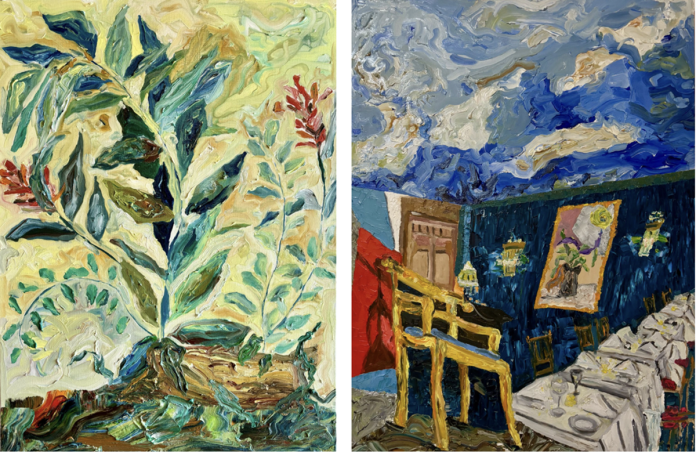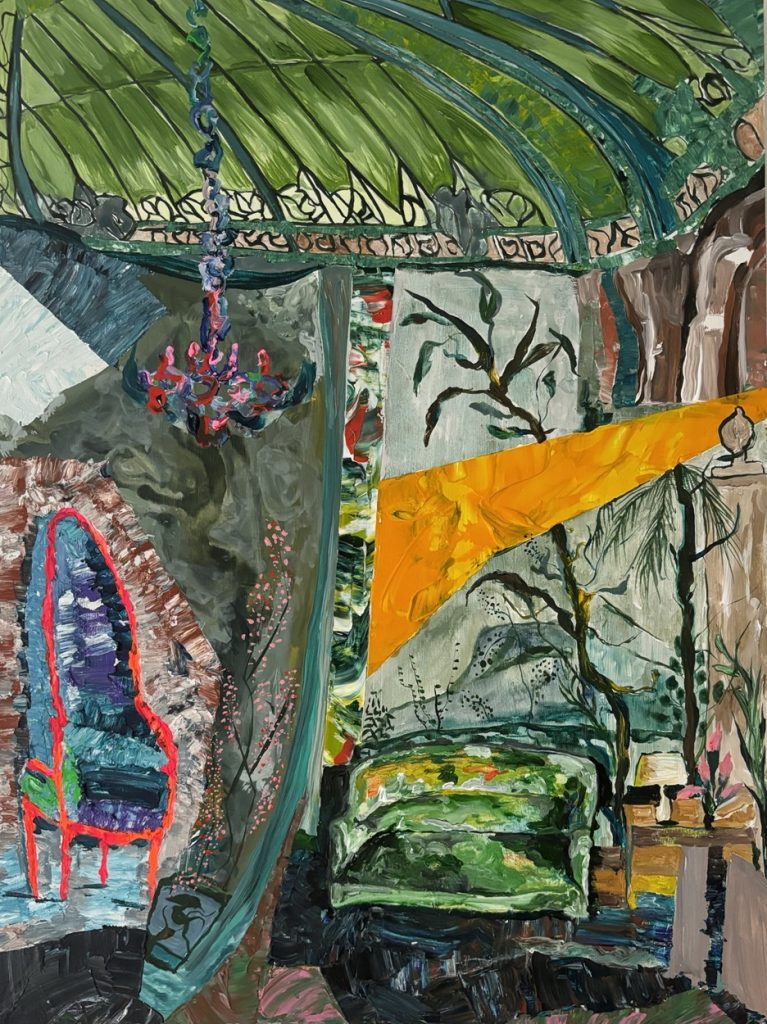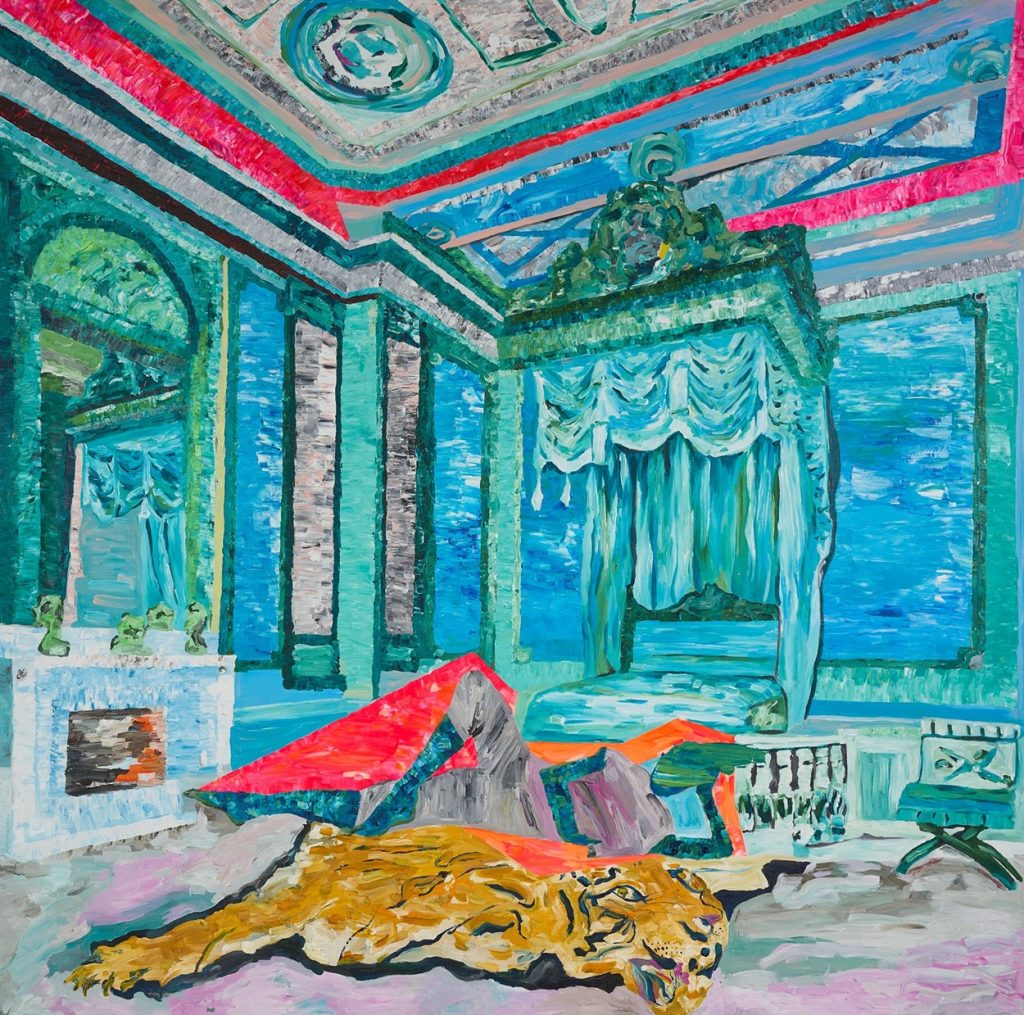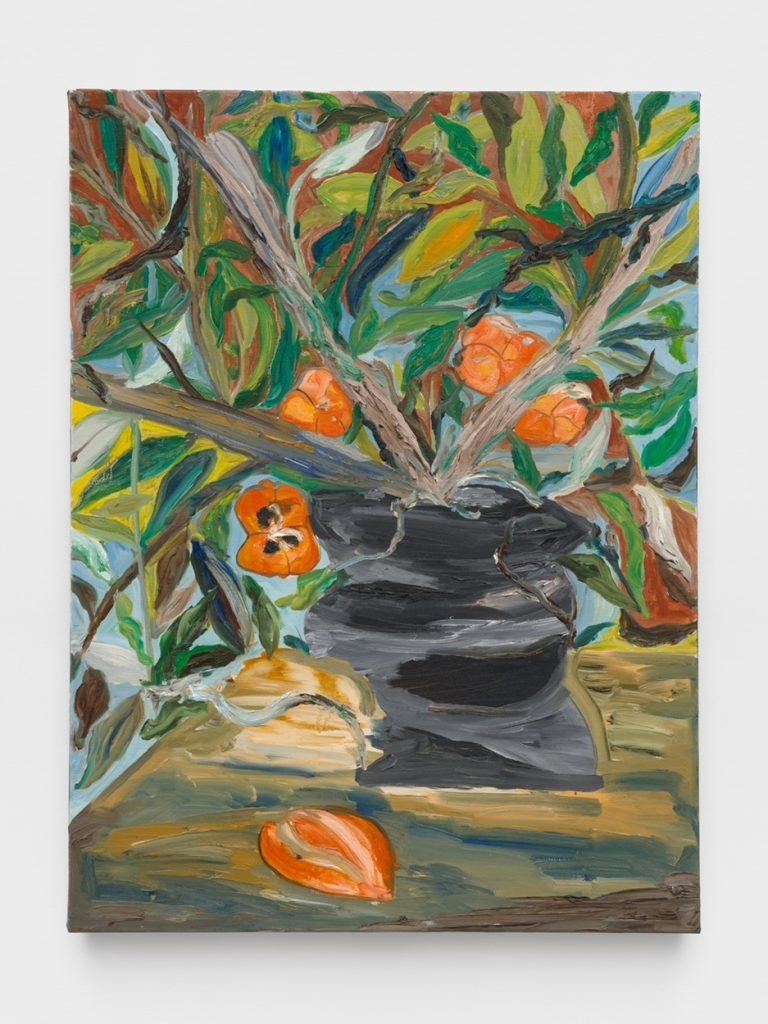
Duran’s tropical dreamscapes and opulent interiors unveil untold Caribbean histories
Opening Reception | April 10, 2025, 6–8pm
(NEW YORK, NY — March 25, 2025) — Hannah Traore Gallery is pleased to present Aleluya, a solo exhibition by Jose Duran opening April 10, 2025. Across two series of paintings, Duran weaves opulent interiors with vibrant tropical botanicals to uncover the stories of the Caribbean under colonialism. The Dominican artist’s practice is informed by his multidisciplinary background in painting, design, and sculpture, as well as a commitment to historical research. This dazzling body of work invites viewers into Duran’s vivid imagination where fantasy and history convene.
Duran’s sumptuous works tactfully and beautifully engage with colonial history and the African diaspora, particularly within the Caribbean. Aleluya presents two interconnected bodies of work, the first a series of paintings inspired by Cuban Rococo architecture and interior design. His ornate scenes are set in 19th century salons and mansions, which were built by colonial elites who fled Haiti for Cuba after the Haitian Revolution. It was a period of nascent prosperity for a continent whose wealth was growing due to the
resources pillaged from the slave trade. Duran’s depictions of these lavish interiors are often named after Black female figures, centering them to reclaim the spaces indebted to their labor. With these divine reversals, Duran grants the fruits of colonial beauty to the Caribbean people who sustained them. A core inspiration in foregrounding feminine characters in these works is Duran’s late mother, who took great pleasure in maintaining a meticulously kept and decorated home, covering beds in faux satin sheets and draping windows with palatial curtains.

Hua
2025
Oil on linen
18 x 24 in.

Noche
2024
acrylic on wood
18 x 24 in.

Paola
2022
acrylic on canvas
65.5 x 65.5 in.
The second series of smaller scale works are inspired by an investigation into Paula de Eguiluz, a 17th century slave from modern-day Santo Domingo infamous for her powers of seduction through “love attraction plants.” Built upon 15 years of research into the medicinal, poisonous, and seductive plants used by enslaved and native women in the Caribbean, Duran was compelled to honor Eguiluz—who adopted Aleluya as her chosen name—after a 2024 visit to the Palace of the Inquisition in Cartagena where she was put on trial for witchcraft. The resulting floral paintings are luscious vignettes of feminine power, desire, and survival.

Bligia
2023
Oil on linen
18 x 24 in.

Priscila
2024
oil on linen
18 x 24 in.
Duran’s tropical dreamscapes present a resplendent reversal of Afro-Caribbean history. It is a poised and graceful reclamation, a heartfelt celebration of cultural resilience. More than that, his works are odes to the beloved woman who inspired him from birth. Duran’s late mother was a trusted friend, advisor, and unofficial therapist to countless neighborhood friends in the Bronx, and earlier in Duran’s childhood, in the Dominican Republic.
She was a hairstylist working from her home, which was always brimming with clients. She delighted in hosting soirees, enchanting guests with jokes and stories even when hard at work. Duran dreamed of someday buying her a new home in New York, and when she passed, he turned to painting to help him heal. Aleluya, Duran’s latest exhibition, is a testament to the artist’s work, personal and painterly, of that healing; and of envisioning the places, warm and bright, where we nurture our brilliance.
ABOUT JOSE DURAN
Jose Duran (b. 1979, Moca, Dominican Republic) is a painter, designer, and sculptor creating fantastical worlds of cosmopolitan opulence and sumptuous, even dangerous foliage. Duran’s practice is anchored in extensive research of practices of survival, celebration, vengeance, sabotage, and aspirational desires in Black communities. He draws from baroque and rococo interiors to create scenes of architectural lavishness and femininity, producing complex compositions anchored in whimsy and play.
Duran centers Black feminine figures as a reclamation of their contributions to European markers of taste, and as retribution for their forced labor under colonial rule. Duran’s fantasies retrospectively place Black women at the center of his lavish interiors, where they reap the fruits of their labor. His practice is an ode to the dreams and aspirations of his late mother, who, between the Bronx and the Dominican Republic, would imbue in the artist a taste for cosmopolitanism and beauty.
ABOUT HANNAH TRAORE GALLERY
Hannah Traore Gallery is a space committed to advocating for and celebrating artists who have been historically marginalized from the mainstream narrative. Whether underrepresented, overlooked, or exploited, HTG is building a path forward to share their extraordinary visions with the world. The gallery exhibits artists from all around the world, selected based on their exceptional talent and distinctive voice.
HTG values connections—with artists, collectors, brands, and institutional spaces—and maintains a focus on building true and lasting relationships. Understanding that art is in constant dialogue with design, fashion, media, and the ever-changing world around us, HTG is dedicated to broadening the notion of what is deemed appropriate for the gallery setting. In doing so, HTG aims to engage both novice and experienced audiences in new ways.
The gallery and its exhibiting artists have been featured in the New York Times, Vanity Fair, The Guardian, ELLE, Harper’s Bazaar, W Magazine, V Magazine, Frieze, Forbes, Cultured, Wallpaper, The Art Newspaper, Artsy, ARTnews, Document Journal, DAZED, Galerie Magazine, and more.
PRESS INQUIRIES






























